Action Comedies in Anime and what we can Learn from Them
Saturday , 17, February 2018 Uncategorized 9 Comments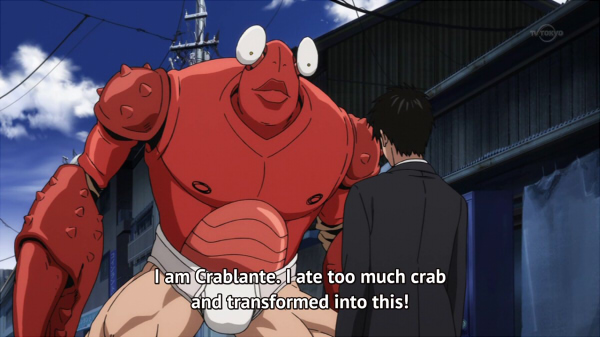
A dire warning to sushi lovers everywhere!
Perhaps influenced by Anthony’s recent article and the ensuing discussion, I decided to watch anime for the first time in a few years, settling on the series One Punch Man. It follows the exploits of heroic, dull-witted Saitama, who decides to become a costumed hero after failing a job interview and encountering a half human, half crab mutant in his underwear attacking people nearby. Unfortunately, after three years of training, he has reached a point where he kills every opponent with a single punch, leading to a boring existence where no villain, no matter how terrifying or deadly, presents any challenge to him. The series is very good, both action-packed and funny, and made me think about anime action comedies in general.
The genre (and this applies to Japanese live action movies, too) presents an interesting dichotomy right off the bat. On the one hand, the Japanese are fantastic at action. The choreography of the fights, the ebb and flow of the action, the way they build up villains as all-powerful, horrifying menaces, and protagonists as the ultimate, tough, stoic heroes is masterful and worth studying.
On the flipside, they are terrible at comedy. With a small handful of exceptions, comedy anime lacks jokes, have poor “beats”, and are full of hokey, canned humor. I don’t think this can simply be attributed to a difference in tastes between East and West, either. Not only is one of the exceptions, Detroit Metal City, one of the funniest creative works I’ve ever seen and read, but this doesn’t apply to, say, Hong Kong movies, which are often uproariously funny.
Regardless, this combination of a strength and weakness is important to keep in mind.
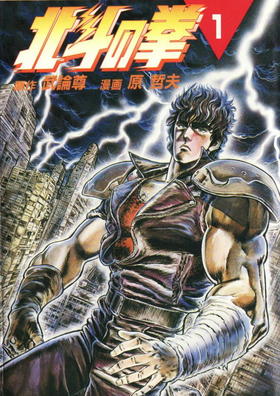
Kenshiro was modeled after Bruce Lee, Mad Max, and Ogami Itto.
Before looking at the pure action comedies, let’s examine a few action series that benefit considerably from humor. First up is the shounen classic Hokuto No Ken, or Fist of the North Star. A favorite of little boys and girls alike in 1980’s Japan, it’s not a series one would imagine to be rife with laughs. Taking place in a post-apocalyptic society heavily inspired by Mad Max, giant, evil punks brutally torture and murder innocent people simply trying to survive the hellish nuclear wasteland. And yet, when the hero Kenshiro arrives to dispense justice on the evil-doers, the resulting comeuppance is often nothing short of hilarious.
Check out this scene. Or this one.
While the major fights between Kenshiro and the other powerful martial artists in the series are kept serious, his disposal of sadistic flunkies, always ending with a deadpan omae wa mou shindeiru (“you are already dead”), is an important element in the show’s success.
If everything was kept serious, the series would quickly become monotonous and a tad depressing, with so many episodes featuring cruel punks victimizing helpless villagers. However, thanks to the more humorous approach, one is constantly looking forward to the punishment Kenshiro will dole out to the villains, which is as gratifying as it is funny. And it stays fresh and interesting, since they always change it up.
Lastly, while I love a good dub, Hokuto no Ken has to be watched with subs, to the point where it’s a far worse, even different show in the English translation. The anime is a phenomenal voice-acting achievement, with Akira Kamiya perfectly encapsulating Kenshiro’s stoicism and coolness through the smallest tonal inflection, and the late, great Kenji Utsumi conveying the overwhelming power and ruthlessness of the main villain Raoh. Credit the voice acting with much of the aforementioned humor, or how memorable the character’s toughness and emotions are. In fact, I struggle to think of an anime where the voice acting had this much significance. (Most times, it’s a non-factor for me in rating a series) Needless to say, the English translation is not up to the task, being poor even by regular anime standards, and making Kenshiro sound like a nebbish, dweebish schoolteacher.
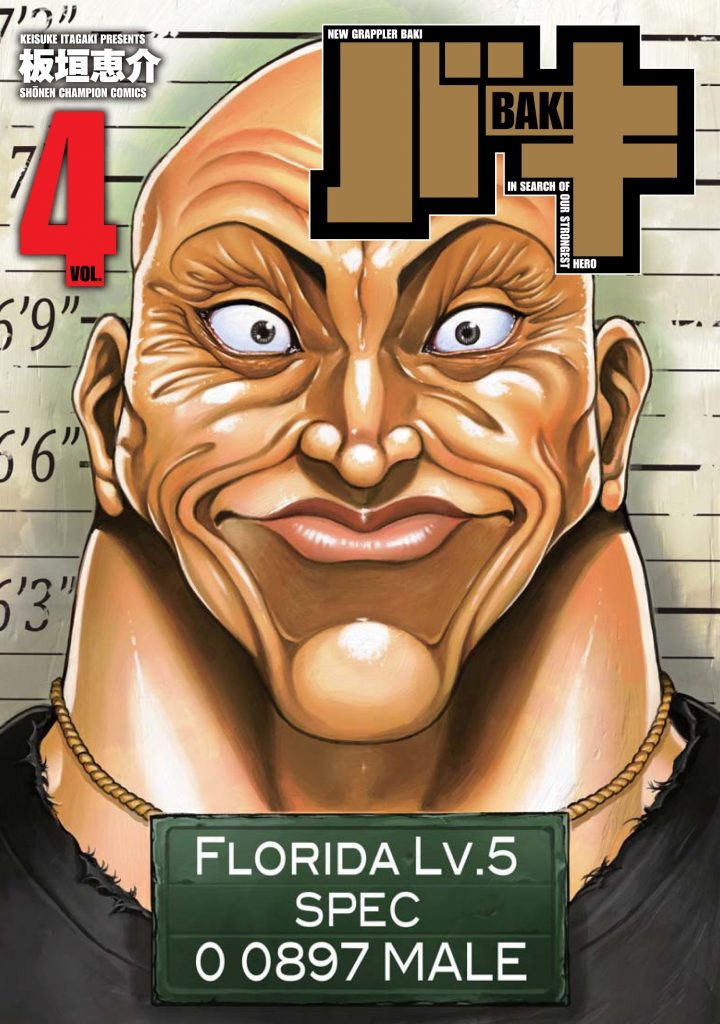 Another good example of comedy being used in an action series is in Grappler Baki. Here, the humor comes from a different source. Namely, how ridiculously over-the-top everything is. While it occurs in the manga, one scene perfectly crystallizes this. The monstrous American convict Spec has escaped from a maximum security prison, killed countless guards, and made his way to Japan. At one point, he comes across several generic Japanese delinquents, one of whom is holding a gun. What does he do in this situation? One might think he would beat them up or kill them, despite the firearm. Or perhaps he would even take the gun and crush it in his hands. That’s what one usually does to build up a big, scary villain, right?
Another good example of comedy being used in an action series is in Grappler Baki. Here, the humor comes from a different source. Namely, how ridiculously over-the-top everything is. While it occurs in the manga, one scene perfectly crystallizes this. The monstrous American convict Spec has escaped from a maximum security prison, killed countless guards, and made his way to Japan. At one point, he comes across several generic Japanese delinquents, one of whom is holding a gun. What does he do in this situation? One might think he would beat them up or kill them, despite the firearm. Or perhaps he would even take the gun and crush it in his hands. That’s what one usually does to build up a big, scary villain, right?
Well, author Keisuke Itagaki takes it a step further. See, Spec bemusedly takes the gun from the delinquents, and then, remarking that such little toys can’t hurt him, proceeds to shoot himself in the face, blowing off a portion of his cheek. One can’t help but laugh at such a creatively absurd situation. Yet again, this humor is vital in keeping the series fresh. Any power fantasy, no matter how well-executed (and Grappler Baki does it better than anyone, in my view), can become monotonous self-parody if not spruced up with the occasional wink-and-nod from the creator.
Moving on to actual action comedies, one can learn much from 1988’s Sakigake!! Otokojuku. With a main character who is a blatant rip-off of Kenshiro, it takes place in the world’s toughest and most brutal high school, a Japanese all-male institution where every student is a powerful fighter, teachers make the students go through insane physical challenges, and crazy duels to the death break out constantly.
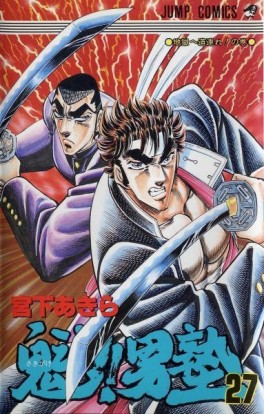
A big hit during the late 80’s, it is largely forgotten nowadays. In this case, it’s perfectly just.
It starts off promisingly enough, with fun fights and the humor being a combination of how over-the-top the school is and the ways the main character humiliates the sadistic teachers. Unfortunately, the series loses its path halfway through, completely abandoning the comedy and turning into a melodramatic series where a powerful student dies each episode, everyone cries and mourns him, only for him to come back later. In this, it’s badly aping Hokuto No Ken. The latter series had (genuine) character deaths and was meant to be occasionally emotional, but these moments were few and far between, so they actually meant something. In Otokojuku, its regularity and meaninglessness makes it eye-rolling emotional miasma.
There is also a disconnect in settings. Characters dying in the brutal nuclear wasteland of Hokuto No Ken makes sense. Teens dying in modern-day Japan, under the full knowledge and participation of the school principal, who is portrayed as a positive hero, makes the series idiotic and perverse.
Lastly, Hokuto No Ken never abandons its humor, even near the very end. Otokojuku does, and it becomes borderline unbearable when combined with the weepiness.
For another stark example of what not to do, consider Bobobo-bo Bo-bobo. Set in a futuristic world where the protagonist, sporting a golden afro, must defeat an evil emperor, it’s supposed to be a parody of other anime. Unfortunately, “parody” here means “make a reference to, without any actual jokes or commentary”. For me, it simply reminded me how much better those other shows were. And unlike the other examples we looked at, Bobo is downright silly, with characters constantly yelling in an exaggerated, silly manner, chibi animations, nonsensical fights and “random” events, etc. This could potentially work in a pure comedy, but in an action comedy, it robs the fights of any stakes or interest a viewer has in them. This is in start contrast to Grappler Baki or Hokuto No Ken, where the combatants and fights still maintain complete credibility. Here, the bad comedy makes the fighting worse and irrelevant, leading to a series that is torture to sit through.
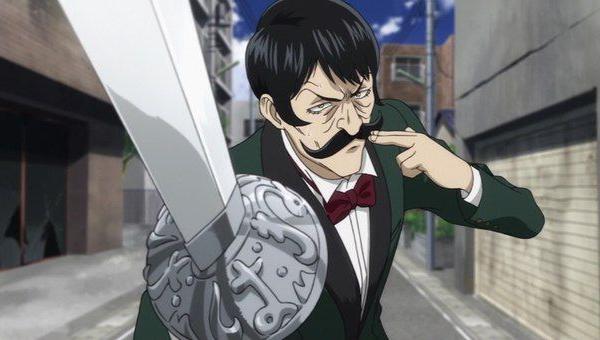
Better, more original character design than most anime leads.
Which brings us back to One Punch Man. Despite being much sillier than Hokuto No Ken, and featuring ridiculous villains and heroes, (a sexy, buxom, insect-like villainness called “Mosquite Girl” and a hero who looks like Snidely Whiplash being a waiter called “Spring Mustachio” were particular highlights) the fights are always treated seriously. They are animated and choreographed exceedingly well, far better than in most straight action series. Some of the humor is based on parodies of other properties, but it has actual observations to make, and is not reliant upon it. The premise itself is funny, and frequently exploited; a random guy attains ultimate power, but it only makes his life boring as he no longer finds combat exciting. Furthermore, he still lives a standard, humdrum life in his modest apartment, watering his plants and getting excited for weekend sales. The fight scenes would make for a good action anime by itself, and the humor would be enough for a decent comedy. Together, it’s an excellent series, better than the sum of its parts.
We have only touched upon a small number of action comedies in anime, both among those I like and those I don’t. Still, we have gleaned many important lessons from the ones we examined above.
Most importantly, humor is a vital element for most action series, not just action comedies, keeping it fresh and exciting, but it should never come at the expense of the fights. And one shouldn’t abandon the humor halfway through, a lesson many Hollywood movies could also learn from.
Kill La Kill is another must see anime action-comedy.
One thing about One Punch Man is they showed what could threaten him in the very first episode: Enough opponents so that they could attack him from all sides while he killed them one at a time.
The Japanese have issues with comedy. (Look into “Manzai” if you’re curious about one of their dominant forms.) A lot of the issue comes down to the structure of the language. When you have to give away the punchline before completing the joke, it causes a deep set of problems.
What you normally see is good series with an episode that’s highly comedic, as they can play on the interior storytelling to setup gags & jokes. The result is they keep a light-hearted nature to the series then toss in jokes here and there.
Action-Comedy isn’t a huge genre in anime normally, but I think the best example is probably “Full Metal Panic Fumoffu”. It’s actually the comedic side-series to the action series Full Metal Panic. It’s also the only time you’ll ever see a Sarin Gas attack used as a joke.
-
And I really should have waited to post until I thought through the breadth of anime more.
JoJo.
More action than comedy, most of the time, but, well, JoJo’s Bizarre Adventure. Yeah, JoJo.
Honorable Mention to Soul Eater, though that’s as much for the legendary Excalibur episode as much as anything else.
Do you have an opinion on action slapstick, along the lines of Rumiko Takahashi?
Inu Yasha and Ranma 1/2 probably fit the description. But I don’t unreservedly endorse either. I’m offering them up for honorable mention, by virtue of their predecessor, Urusei Yatsura, being the funniest animation I have ever seen, period.